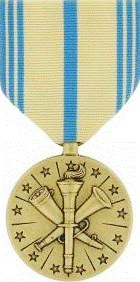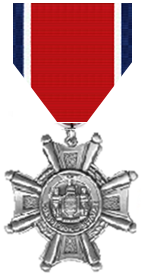The Uniform Code of Military Justice (UCMJ) is the foundation of the system of military justice of the armed forces of the United States. The UCMJ was established by the United States Congress in accordance with their constitutional authority, per Article I Section 8 of the U.S. Constitution, which provides that "The Congress shall have Power. .. to make Rules for the Government and Regulation of the land and naval forces" of the United States.

A military discharge is given when a member of the armed forces is released from their obligation to serve. Each country's military has different types of discharge. They are generally based on whether the persons completed their training and then fully and satisfactorily completed their term of service. Other types of discharge are based on factors such as the quality of their service, whether their service had to be ended prematurely due to humanitarian or medical reasons, whether they had been found to have drug or alcohol dependency issues and whether they were complying with treatment and counseling, and whether they had demerits or punishments for infractions or were convicted of any crimes. These factors affect whether they will be asked or allowed to re-enlist and whether they qualify for benefits after their discharge.
The National Defense Service Medal (NDSM) is a service award of the United States Armed Forces established by President Dwight D. Eisenhower in 1953. It was awarded to every member of the U.S. Armed Forces who served during any one of four specified periods of armed conflict or national emergency from June 27, 1950 through December 31, 2022. Combat or "in theater" service is not a requirement for the award.
A Sea Service Ribbon is an award of the United States Navy, U.S. Marine Corps, U.S. Coast Guard, the U.S. Army, and the NOAA Commissioned Officer Corps which recognizes those service members who have performed military duty while stationed on a United States Navy, Coast Guard, Army, or NOAA vessel at sea and/or members of the Navy, Marine Corps or Coast Guard who have been forward-deployed with their home unit.

The Good Conduct Medal is one of the oldest military awards of the United States Armed Forces. The U.S. Navy's variant of the Good Conduct Medal was established in 1869, the Marine Corps version in 1896, the Coast Guard version in 1923, the Army version in 1941, and the Air Force version in 1963; the Air Force Good Conduct Medal was temporarily discontinued from February 2006 to February 2009, followed by its subsequent reinstatement.
An Overseas Service Ribbon is a service military award of the United States military which recognizes those service members who have performed military tours outside the borders of the United States of America. There are different versions of the Overseas Service Ribbons for the U.S. Army, U.S. Navy, U.S. Air Force, U.S. Space Force, and the U.S. Coast Guard. Both the U.S. Navy and the U.S. Marines receive the Navy and Marine Corps Overseas Service Ribbon.

The Naval Reserve Medal is a decoration of the United States Navy which was created by order of Secretary of the Navy Claude A. Swanson on 12 September 1938. The medal was first issued in 1938 and was an active award until 1958. On 12 September 1958, the Naval Reserve Medal was declared discontinued and was replaced by the Armed Forces Reserve Medal. It is not to be confused with the Naval Reserve Meritorious Service Medal which is a different award that was discontinued on 1 January 2014.

The Armed Forces Reserve Medal (AFRM) is a service medal of the United States Armed Forces that has existed since 1950. The medal recognizes service performed by members of the reserve components and is awarded to both officers and enlisted personnel. The medal is considered a successor award to the Naval Reserve Medal and the Marine Corps Reserve Ribbon, which were discontinued in 1958 and 1967, respectively.

The Air Force Reserve Command (AFRC) is a major command (MAJCOM) of the United States Air Force, with its headquarters at Robins Air Force Base, Georgia. It is the federal Air Reserve Component (ARC) of the U.S. Air Force, consisting of commissioned officers and enlisted airmen. Together, the Air Force Reserve and the Air National Guard constitute the Air Force element of the reserve components of the United States Armed Forces. AFRC also plays an integral role in the day-to-day Air Force mission and is not strictly a force held in reserve for possible war or contingency operations. AFRC also supports the United States Space Force through the 310th Space Wing, pending the creation of a space reserve component.

The United States Navy Reserve (USNR), known as the United States Naval Reserve from 1915 to 2005, is the Reserve Component (RC) of the United States Navy. Members of the Navy Reserve, called Reservists, are categorized as being in either the Selected Reserve (SELRES), the Training and Administration of the Reserve (TAR), the Individual Ready Reserve (IRR), or the Retired Reserve.
Awards and decorations of the state defense forces are presented to members of the state defense forces in addition to regular United States military decorations and state National Guard military decorations. Each of the state governments of the United States maintains a series of decorations for issuance to members of the state defense forces, with such awards presented under the authority of the various state adjutants general and/or respective state defense force commanders.

The Conspicuous Service Cross is a decoration for military service awarded by the State of New York.

The Oklahoma National Guard, a division of the Oklahoma Military Department, is the component of the United States National Guard in the U.S. state of Oklahoma. It comprises both Army (OKARNG) and Air (OKANG) National Guard components. The Governor of Oklahoma is Commander-in-Chief of the Oklahoma National Guard when not on federal active duty. The state's highest-ranking military commander, the Adjutant General of Oklahoma (TAG), serves as the military head of the Guard and is second only to the Governor. The TAG is served by Assistant Adjutants General, all brigadier generals, from the OKARNG and OKANG. The two components each have a senior noncommissioned officer, State Command Sergeant Major for Army and State Command Chief Master Sergeant for Air. The TAG is also served by his Director of the Joint Staff or Chief of Staff, who has direct oversight of the state's full-time National Guard military personnel and civilian employees.
Air Reserve Technicians, commonly referred to as ARTs, are a nucleus of full-time uniformed U.S. Air Force leaders, managers, operators, planners and trainers in what is known as the Air Reserve Component (ARC) of the United States Air Force, the ARC consisting of both the Air Force Reserve and the Air National Guard.
The Active Guard and Reserve (AGR) is a United States Army and United States Air Force federal military program which places Army National Guard and Army Reserve soldiers and Air National Guard and Air Force Reserve airmen on federal active duty status under Title 10 U.S.C., or full-time National Guard duty under Title 32 U.S.C. 502(f) for a period of 180 consecutive days or greater in order to provide full-time support to National Guard and Reserve organizations for the purpose of leading, organizing, administering, recruiting, instructing, or training the Reserve Components according to Subsection 101(d)(6). AGR personnel may also be assigned to active duty roles in support of Regular Army and Regular Air Force organizations or joint organizations such as the Office of the Secretary of Defense, Secretary of the Army, Secretary of the Air Force, the Joint Staff, or the Unified Combatant Commands.
Daniel S. Mastagni is a retired Rear Admiral of the United States Navy Reserve who, from July to September 2003 served as Commander Naval Forces Korea.

The Marine Forces Reserve, also known as the United States Marine Corps Reserve (USMCR) and the U.S. Marine Corps Forces Reserve, is the reserve force of the United States Marine Corps. The Marine Corps Reserve is an expeditionary, warfighting organization and primarily designed to augment and reinforce the active duty units of the Marine Corps in their expeditionary role. It is the largest command, by assigned personnel, in the U.S. Marine Corps.
The reserve components of the United States Armed Forces are military organizations whose members generally perform a minimum of 39 days of military duty per year and who augment the active duty military when necessary. The reserve components are also referred to collectively as the National Guard and Reserve.

An officer is a person who holds a position of authority as a member of an armed force or uniformed service.










